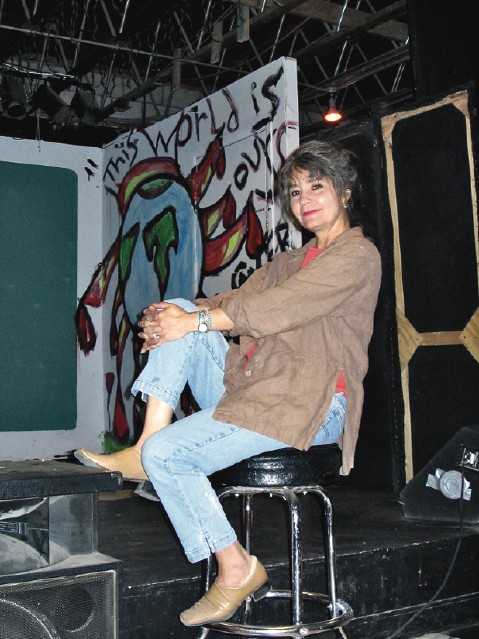Railyard Revisited
In 1997, the Center for Contemporary Arts (CCA) Teen Project handed over its building and program to the newly formed nonprofit organization Warehouse 21 Productions. The goal of Warehouse 21 was, and still is, to provide youth with a place to learn and cultivate their creative nature, gain experience and training to help them enter the job market, and just feel comfortable hanging out. Warehouse 21 offers workshops, mentorships, job opportunities and an all-ages venue in a town where being under 21 means your Saturday night options are limited to home, the bowling alley or the movie theater. The news that the land Warehouse 21 was leasing had been sold to the city was not much cause for alarm. When the new plans adopted by the Santa Fe City Council outlined the destruction of the Warehouse 21 building to make way for a road, Warehouse 21 Executive Director Ana Gallegos y Reinhardt knew the time had come.“It’s time to grow; it’s time to transform; it’s time for the community to support Warehouse 21. It’s time for the railyard to go through its process of transformation,” she says. “It’s just time.”The redevelopment of Santa Fe’s railyard has been a topic on the city’s mind since before Warehouse 21 had even taken over the lease from the CCA. In 1989, the Atchison, Topeka and Santa Fe Railway Company, which owned the 50-acre railyard district, formed Catellus Development Corporation with plans to develop the area into a denser urban-industrial area than the City of Santa Fe wanted. To keep the construction from happening, the city purchased the land and held public meetings to seek citizens’ opinions of what the space should become. After years of discussion, a master plan for the redevelopment of the Santa Fe railyard was drafted and approved by the City Council in 2002. The master plan drew on the input from the public meetings, which included provisions that the railroad continue to run through the historic rail station, a large park and local business opportunities, all while keeping the rugged, gritty look of the railyard they already knew. It also gave priority to the nonprofits already residing in the district, like Warehouse 21.The Santa Fe Railyard Community Corporation (SFRCC), a nonprofit organization, took over the leasing, development and management of the area in 2002. Richard Czoski, SFRCC executive director, says one of the main goals of the project is to make it attractive to everyone—both aesthetically and economically. “What we didn’t want was to have a project that would only attract high-end tourists. There’s enough of Santa Fe that does that now,” he says. “This is a publicly owned ground and we’ve really tried to make it available for a lot of different people.”He says the impression the SFRCC received from community input was that many locals didn’t feel any reason to go Downtown, due to the touristy nature of the area. Czoski says the railyard project intends to provide a community-based area that is more locally oriented by including a plaza area, a large movie-plex, Santa Fe-owned and -operated businesses and cultural activities like those at Warehouse 21.Teen Ideal
After years of healthy debate, Gallegos y Reinhardt and the Warehouse 21 board of directors signed a 50-year lease with the Santa Fe Railyard Community Corporation. The lease guaranteed them a plot of land in the new development, but it was clear that the space they currently use is one of a few non-historic buildings to be demolished during the process. Like the proverbial phoenix rising from its ashes, Gallegos y Reinhardt and the whole Warehouse 21 crew took the prospected demolition and reconstruction as a chance to make the project even better.Edward Mazria, founder of Mazria Inc. Odems Dzurec, the architecture company hired to restore the area, says the old Warehouse 21 building didn’t meet the site’s future needs. The new building, which they hope to start construction on this August, is essentially a metal warehouse with a cement black-box performance space inside. It’s a building inside a building, Mazria says. In order to work within the budget, the first stage of rebuilding Warehouse 21 will be making the metal shell and the performance space. As Warehouse 21 raises more funds, they can continue to add office spaces, a darkroom, a small coffeehouse, a recording studio, a second performance space and whatever else they could need.Mazria, whose daughter frequented Warehouse 21 during her teenage years, says the venue is a great place for teens and young adults to be. “For us, Warehouse 21 was really a blessing,” he says. “It’s an incredible contribution to the City of Santa Fe.”Rail Runner and Beyond
“We’ve been talking about the commuter rail and the redevelopment planning for 10 years,” Gallegos y Reinhardt says. “It’s all been a fantasy for us.”With the anticipated launch date of the Rail Runner route between Santa Fe and Albuquerque in late 2008, just months after the projected completion date of the Santa Fe Railyard project, the fantasy is coming to fruition.“It’s here,” Gallegos y Reinhardt says. “I’ve been waiting for so long.”When the link is established, it will provide another valued activity for the youth of both cities—to take day trips to hang out in a different area and check out a different, yet meshed, music scene. It all just rides on the timetable and train fare.Call 346-0660 ext. 247 with news tips. E-mail your guest editorial or letter to letters@alibi.com. To contact the author, e-mail amy@alibi.com.





